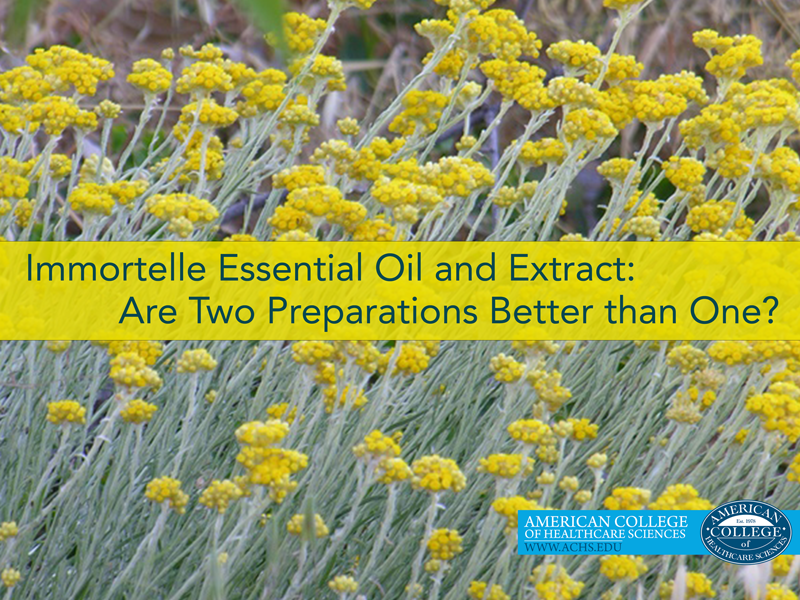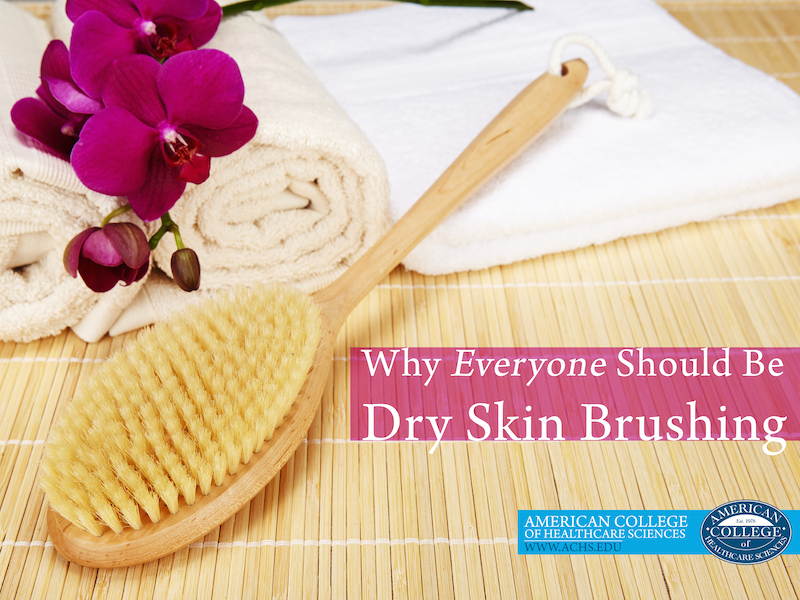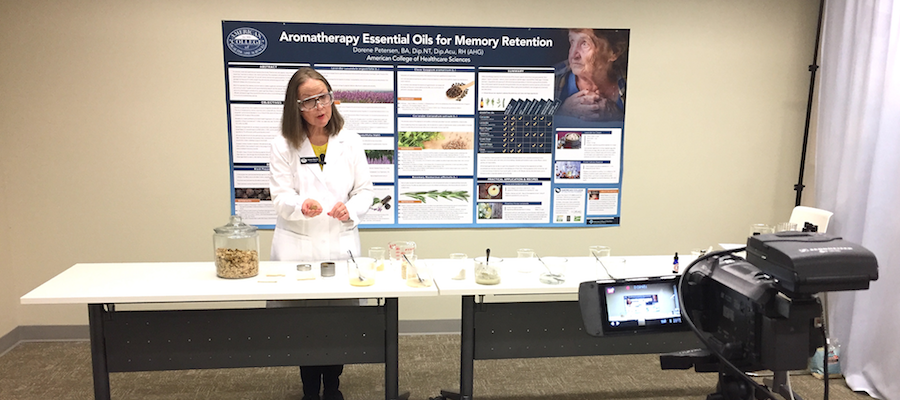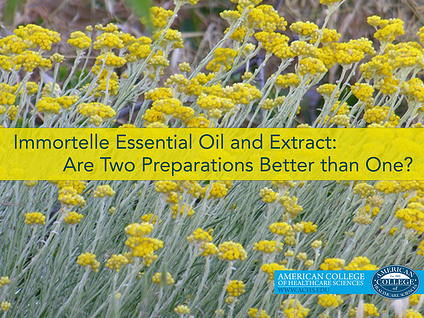
**The full text of this article is published in the special essential oils edition of the Journal of the American Herbalists Guild, Vol. 13 No. 1**
The plant commonly called “immortelle” has another, more historic and enchanting name: helichrysum.[1] The word “helichrysum” draws its roots from the Greek helios, meaning “sun,” and chryos, meaning “gold.” So the “sun gold” plant was named for its vibrant golden flower, but also because the ball-shaped blossoms do not wither.
First-century Roman naturalist Pliny the Elder said the small golden flower was used for crowning the gods:
It has small white branches, with leaves of a whitish colour, and the flowers, which grow in clusters, glisten like the gold in the rays of the sun. They are never known to fade, hence it is that they make chaplets of it for the gods, a custom which is most faithfully observed by Ptolemy, the King of Egypt (Newberry 430-431).
In the language of flowers, Helichrysum spp. (immortelle) symbolizes eternal or endless love (Seaton 180). Both ethereal uses speak to the power and prestige of this plant, which has also been praised by herbalists for centuries.
Historically, immortelle was used for all scrofula ailments, especially those dealing with the skin. Traditionally, herbalists have used the herb as a tincture or fluid extract for its anti-inflammatory and antibacterial properties, specifically for wounds, cuts, abrasions, and scars, which remain some of its most common applications today. But it is also a popular and highly effective essential oil—especially when used for its antibacterial, anti-inflammatory, and antioxidant properties. Combining both the essential oil and herbal extracts provides an even more powerful and effective remedy, and this is primarily what this article about the healing “sun gold” plant will address.
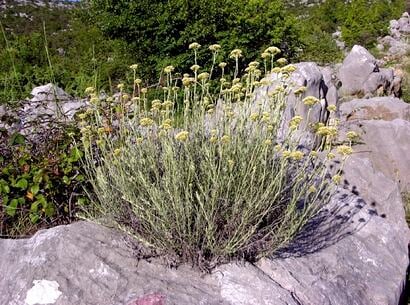 Botanical Sources for Immortelle
Botanical Sources for Immortelle
Photo: Helichrysum italicum ssp. italicum in its natural habitat, the Adriatic coastal region. Image reproduced with permission from Ana Rangus’ Essential oil and Flavour/Fragrance Sector in Western Balkan Countries, a PowerPoint presentation delivered at the 2014 International Federation of Essential Oils and Aroma Trades (IFEAT) Conference in Rome.
Several varieties of Helichrysum spp. are commercially available. Some estimate as many as 600 species worldwide, with more than 20 of those species native to the Mediterranean area (eight of these species belong to the Italian flora) (Pignatti 1982). Some of the most common species of immortelle used for aromatherapy essential oils include: H. angustifolium, H. italicum, H. stoechas[2], H. gymnocephalum, H. plicatum, H. arenarium, H. decumbens, and H. graveolens.
A member of the Asteraceae family, immortelle is a perennial plant that grows approximately eight inches high. It has whitish lanceolate leaves covered with short, dense, matted hairs. The “sun gold” flowers are small and grow in clusters called cymes appearing at the pinnacle of the plant (Davis 1997, Wichtl 2004).
Immortelle is native to central and southern Europe, the Mediterranean region, North Africa, Poland, Turkey, and the former U.S.S.R. It is cultivated in Italy, Croatia, Corsica, in the Carmargue and Provence areas of France, and most recently farmed in Serbia.
But as previously mentioned, Helichrysum is a large, widespread genus, aided by its xerophyte nature (adaptation to survive in a dry environment). Much like fellow Asteraceae family member Helianthus annuus (sunflower), immortelle will grow in poor-quality soil so long as it receives enough sun, though the plant prefers sandy soil. In fact, Helichrysum spp. are dispersed from the lower-intermediate Mediterranean, growing at a wide range of altitudes from sea level up to 1,700 meters (approximately 5,570 feet) above sea level, preferably in sandy or loamy soils (Perrini, Morone-Fortunato et al, 2009).
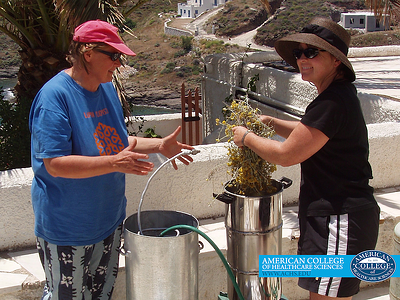 Immortelle Essential Oil Background
Immortelle Essential Oil Background
Photo: Dorene Petersen distilling immortelle essential oil in Greece. Image by American College of Healthcare Sciences. © 2012
Immortelle essential oil is distilled from the flowering tops of the plant. The plants should be distilled when the flowers are fresh, as the flowers begin to ferment 24 hours after being harvested, which can impact the constituent profile and reduce the therapeutic efficacy of the essential oil. Since the yield is low, H. angustifolium is often distilled with other varieties, like H. orientale. While this typically will improve the quantity of the yield, it will also impact the constituent profile and create a very different end product. Ideally, immortelle essential oil that is used for clinical therapeutic aromatherapy is distilled from a single species.
Immortelle absolute, which is solvent-extracted, is also available commercially. The solvent extraction method is frequently used to extract volatiles from flowers particularly if the aromatic molecules within the flower cannot be extracted via steam.
In solvent extraction, the flower petals are first mixed into a volatile solvent (such as petroleum, ether, benzene, or hexane) until the volatile components are completely dissolved. The solution is then filtered and the solvent is evaporated out at reduced pressure.
The initial result of solvent extraction is called a “concrete.” The concrete still contains insoluble vegetable wax and pigments, so it is further processed by solvents and freezing to separate out the waxes. The final product is the absolute. Most of the solvent is removed from the absolute by vacuum pressure without using heat. However, there is usually a small amount of solvent remaining in an absolute (up to 1-2%). For this reason, many aromatherapists prefer not to use absolutes for essential oil therapy.
Enjoying this article? Click here to find the full text of my article inside the special essential oils issue of the Journal of the American Herbalists Guild, Vol. 13 No. 1.
Disclosure of Material Connection: I am the President and Founder of American College of Healthcare Sciences, the Institution that publishes this blog. However, all opinions are my own. This blog may contain affiliate links. I am disclosing this in accordance with the Federal Trade Commission’s 16 CFR, Part 255: “Guides Concerning the Use of Endorsements and Testimonials in Advertising.”
This article is for informational purposes only. It is not intended to treat, diagnose, cure, or prevent disease. This article has not been reviewed by the FDA. Always consult with your primary care physician or naturopathic doctor before making any significant changes to your health and wellness routine.
References
Davis P 1997, Aromatherapy: An A-Z. Daniel Company Limited, London, UK, p 143
Guenther E 1948, The Essential Oils: Volume VD. Van Nostrand Company Inc, New York, p 467
Morone-Fortunatto, Montemurro et al, 2010, Essential oils, genetic relationships and in vitro establishment of Helichrysum Italicum (Roth) G. Don ssp. Italicum from wild Mediterranean germplasm Industrial Crops and Products. 32:639-649
Newberry J 1889, On Some Funeral Wreaths of the Graeco- Roman Period, Discovered in the Cemetery of Hawara. The Archaeological Journal. XLVI:430-431
Perrini, Morone-Fortunato et al, 2009, Glands, essential oils and in vitro establishment of Helichrysum italicum (Roth) G. Don ssp. Italicum Industrial Crops and Products. 29:395-403
Pignatti S 1982, Flora d’Italia: Volume 2. Edagricole, Bologna, Italy
Seaton B 2012, The Language of Flowers: A History. University of Virginia Press, Charlottesville, p 180
Wichtl M (Ed) 2004, Herbal Drugs and Phytopharmaceuticals: A Handbook for Practice on a Scientific Basis. CRC Press, Boca Raton, p 282
Wichtl M (Ed) 2004, Herbal Drugs and Phytopharmaceuticals. (3rd ed). Medpharm, London, UK
[1] Helichrysum: In popular literature, you might also see immortelle called everlasting flower, yellow chaste weed, St. John’s weed, Italian straw flower, Herbe de St. Jean, immortel, and curry plant (the leaves smell like curry when they are crushed).
[2] The difference between H. angustifolium and H. italicum is purely nomenclature; H. angustifolium and H. italicum are the same according to Guenther (Guenther 1948). H. stoechas, however, is a distinct variety, and when H. angustifolium and H. stoechas are distilled together, this is referred to as “oil of helichrysum.”

